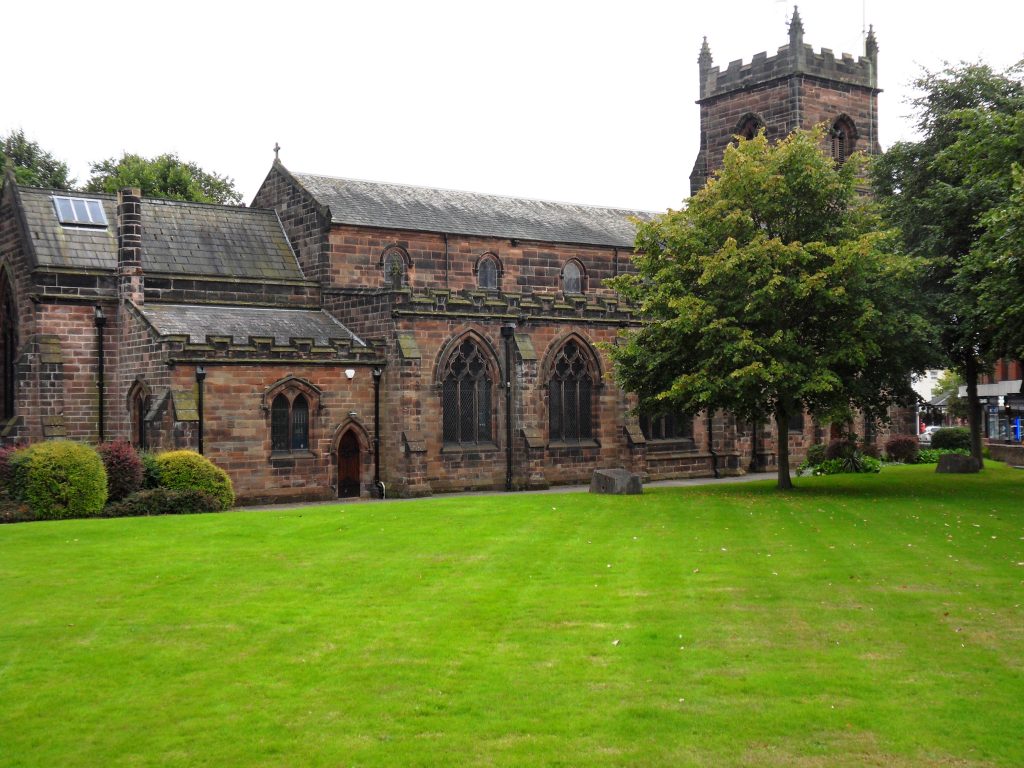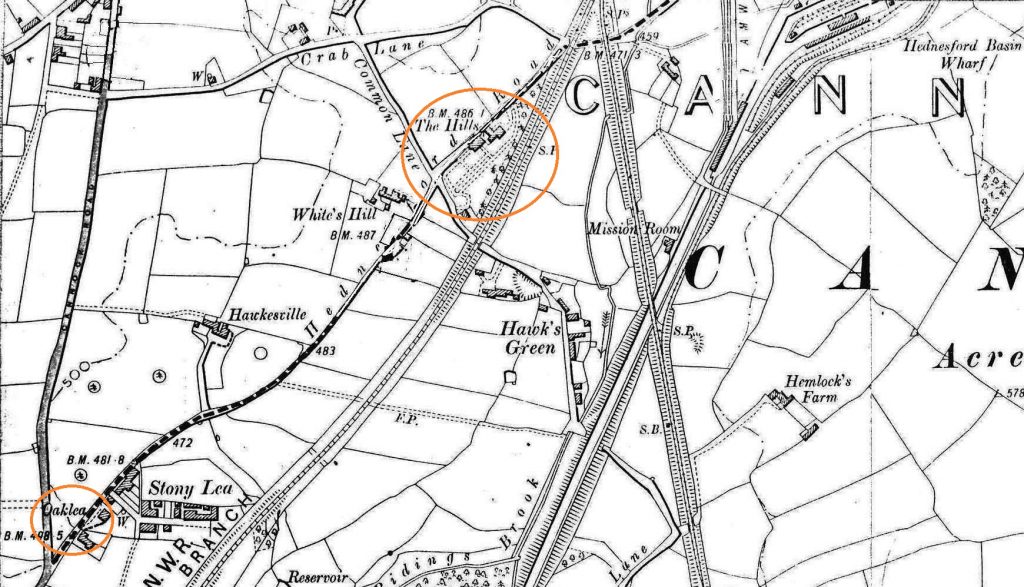How I wish I had a photo! I`m sure there is one in the family album.
Francis my gt.gt.grandfather marries Sophia Bourne (nee Tredwell) in 1843 in Marylebone, London. in 1847 when his father Joseph died, the family stone mason business was sold and in 1851 he and Sophia and daughter Eliza (7) (my gt.grandmother), John (4) and Mary Sophia (3) are living in Hiver Hall, Hendon along with Francis` widowed mother Elizabeth (59) and Francis` sister Mary Anne (20) now governess to the children. Francis is stated to be a farmer of 150 acres with 2 labourers. In 1861 he and Sophia are in Hednesford Lane, Cannock and in 1871 White Hill House, Cannock. In 1881 and 1891 he is at The Hills, Hednesford. These moves confirm the working with the various contracts as at each place Sophia had a child.
I have to thank Derek Davis who is the researcher for the Chadsmoor (Cannock Chase) Local History Society for his hard work and ‘sleuthing’ in providing the following information and photographs. Also David Hope with whom I was in touch some years ago, mainly concerning the Suffield Family.
Derek reports – By the time Francis was 21 (1841) he had left home and was believed to be living in the village of Hartington near Leek, with a blacksmiths family called Gilman and one can reasonably assume he was working on the construction of the Leek to Buxton local railway, either as a stone mason (his fathers occupation) or as a blacksmith working for Mr Gilman. Had he already come into contact with the Bourne family, and even the Tredwells, because by marrying Sophia in 1843 he formed a close working arrangement with Sophia`s brother William Tredwell which was to last until 1871 when William died. In 1850 Francis was very important here on Cannock Chase being the Managing Director of one of the first deep coal mines, I have also found his importance in Railway Contracting particularly on our Walsall to Cannock line. However I have found that his Brother in Law William Tredwell was even more important in the Railway world and actually built more than 30 Railway Lines Nationally and had workshops and offices in Gloucester.
On September 1st 1860, Francis signed a contract with the Birmingham Canal Navigation Co. to construct a tramway linking the canal basin at East Cannock with his new mines at Old Hednesford. That tramway was completed by 1862.
Another great piece of information came to light via this website from a lovely lady called Lorna in Northampton who contacted me to say she had acquired a box of letters in an antique shop. One of these letters was dated 1860 from a Henry Bramall (later discovered to be a mining engineer) to his father informing him of his arrival at Hednesford and his welcome by Mr Piggott. I think he was only with Frances Piggott a short time as by 1861 Henry is back home with his parents. Extract from letter regarding Francis – “I got here on Saturday at 1 o’clock and came straight up to the Colliery. Mr Piggott was very glad to see me and we had a walk over the Estate he laying down to me all his plans. Some of these were crude enough but he seems to be a very decent straightforward sort of man, but surrounded with a lot who are taking advantage of him in every imaginable way. A worst designed place I never saw, but I have no doubt I will yet be able to alter the state of things very materially.”
By 1855 all the railroads north of the South Staffordshire railwayline were purely of local significance and primarily canal feeders. However, a through connection between Walsall and Rugeley was formed by the Cannock Branch of the South Staffordshire Railway Company and opened in 1858 and north of Cannock by the Cannock Mineral Railway Company in 1859. Hednesford`s passenger railway station was opened in 1859 and the line was leased to the LNWR by 1860.
Francis had seen the possibilities of growth in the area and had leapt at the opportunity. By 1862 he had been proved right because in that same year the Cannock Chase Railway proposed a new line to be constructed from the Hednesford line to Cooper’s Lodge, going through Heathy Leasows, Piggott’s new mines would then have direct connection to both canal and main line railway and success and wealth followed.
Newspaper clipping: January 12, 1865 – Hednesford Colliery Company (Limited). The first meeting of this Company was held at Hednesford Colliery on Tuesday. There were present William Tredwell, Esq., of Handsworth, in the chair Charles Bell, Esq., London, G L Clowson Esq. of Sydenham, L. Adamson Esq., Armitage, John Tredwell Esq., Leigham Court, Brixton Hill, Mr Piggott, Mr Foster, and Mr W V Houghton etc. After the meeting the company inspected the colliery and works, and then proceeded to the open work, which is certainly a very extraordinary geological formation. Below the top soil is 5 feet of brick clay, immediately below which is 5 feet of coal, 6 feet below the coal is 1ft 6ins of valuable ironstone, and immediately below the ironstone lies a very fine white fire clay, the depth of which is not ascertained yet. The quality of the coal being got at this colliery is very good, and altogether this colliery bids fair to be a promising investment. Afterwards they adjourned to the Cross Keys Hotel, Hednesford, where an excellent dinner was provided by Mr and Mrs Wilkins.
In 1894, with £60,000 capital, he formed the Hednesford Colliery Company, but disaster was soon to strike! Coal was always at the mercy of market prices, obviously cheaper in the summer than in the winter. The cost of drawing coal from the faces however, remains the same. One possibility, though never popular, was the pay to miners less in the summer months; the other was to cut their working hours. Those solutions were tried in most areas with the inevitable disputes with the workforce. The difficulties met by Piggott were to be encountered again with other colliery companies but in 1870 they were way beyond the horizon.
I have still not been able to identify a photo/picture of Francis but feel sure he must be one of the unidentified items in the ablum mentioned in the introduction. Please see ‘unidentified photos‘ if anyone can help!
Funeral report for Francis Piggott 23rd February 1897
The obsequies of Mr Francis Piggott, who was closely connected with the Cannock Chase district for over 40 years, took place on Tuesday last in the Cannock churchyard, where the body of his deceased’s wife lies. The remains were conveyed from Canterbury House, Erdington, where the deceased had resided of late years, in a hearse, by way of Sutton Coldfield, and on to Cannock Railway Station, where it was met by the sorrowing members of the family and friends. The funeral cortege then proceeded to the Parish Church, where the beautiful but impressive service appointed for the burial of dead by the Church of England was gone through. The service, which was attended by a large number of inhabitants, was conducted by the Rev. Thos. Rogerson (rector of Wrockwordine Wod), Rev. Prebendary Bolton (Lichfield), and the Rev. G. Roper (Brewood), all o f whom, at one or another time had been connected in church work with the deceased gentleman, who was highly esteemed and respected. The mourners were Mr and Mrs John Piggott (Selly Oak), Mrs. Chas. Twynam (daughter), Mr F. Bradley (son-in-law), Mr and Mrs Walter Piggott (nephew and niece), Miss Piggott (niece), Mr Ernest Bradley (grandson), Mr H.W. Elliot Esq., J.P., and H. J. Elliot, Esq., Amongst those who attended the service were the Revs. A.H. Lanfear and G. Rosber, Mr F.D. Rumsted, J.P., Mr N. Chandler, Mr James Hopwood, Miss Robinson, Miss Partridge and Miss Lydia Howell. The closing sentences of the service were said by the Rev. Preb. Bolton at the graveside, and here he also delivered a short address, in which he referred in the highest terms to the character borne by the deceased, and also remarked that he was one of the first to welcome him to Cannock, and a most ardent worker for the Church during the time he was there. The coffin, which was of oak, with shell, and fitted with brass fjurniture, was covered with a number of beautiful wreaths, and the inscription thereon contained the following particulars: “Francis Piggott. Born, March 12th, 1820. Died, October 21st 1897”. Wreafhs and floral tributes were sent by the following:- Mr and Mrs John Piggott and Mrs Hodgson, Mr and Mrs Bradley, Mr and Mrs Twynam, Mr F.C. Bradley and Miss Page, grandchildren from Southport, Mr H. W. Elliot, J.P., Mr and Mrs Walter Piggott, Mrs Plant and family, Miss Alice Houghton, Miss Grace and Mr E Howard.


